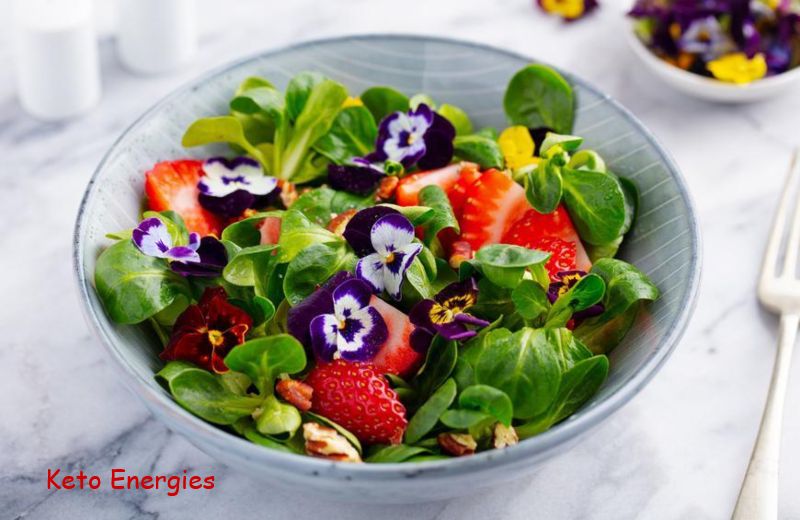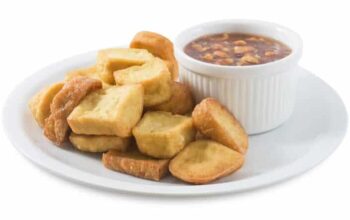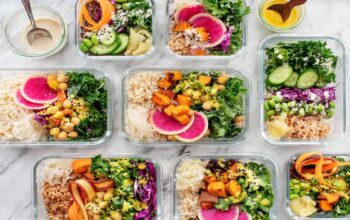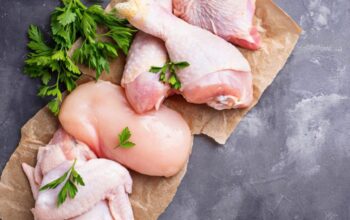During the days of Shakespeare plays, audiences snacked on delicacies like stewed primroses and drank rose water and cordials made from carnations. During Elizabethan times, flowers were a staple in kitchens and at major events. And cooking with flowers didn’t start there. One written account of the dishes served at a medieval feast mentions that “marigolds seasoned the venison, roses graced the stew, and violets mingled with wild onion in the salad.” In short, edible flowers are the feather in a dessert maker’s cap. Use small whole flowers such as pansies, Johnny-jump-ups and nasturtiums for a splash of color or pick petals from larger flowers such as calendulas and marigolds and sprinkle them like confetti . Be sure to choose pesticide-free blossoms specifically grown for use as food.
Edible Flowers: A Complete Guide
In America, edible flowers played a role in the kitchen since colonial times. They arrived with the English settlers and were used to make teas as well as flavoring for punch, cake, preserves, jams and jellies. Another popular use was a a colorful garnish on salads.
Actually, almost all of the world’s cuisines use edible flowers. Asian cooking often calls for daylily buds; rose petals are common in Indian food; and many Italian dishes include Squash Blossoms.
Flower Flavors
Flowers appeal to far more than the eye; they get your taste buds going, too. Edible flowers all have unique flavors. The most commonly available edible flower, nasturtiums, has a bright peppery flavor. Borage flowers have a hint of cucumber (its tiny yellow blossom is also edible). Johnny-jump-ups have a wintergreen-mint flavor. Roses and violets have a sweet taste that is perfect for desserts. Zucchini Blossoms lend their unique flavor to this delicious Zucchini Blossom Frittata.
Some other popular edible flowers and their flavors are:
- Begonia: Lemony and crisp
- Carnation: Spicy
- Chive Blossom: Mild chive
- Chrysanthemum: Bitter to very bitter
- Daylily: Crisp and sweet
- English Daisy: Grassy and tangy
- Geranium: Vary greatly according to variety
- Impatiens: Very bland
- Marigold: Spicy
- Orchids: Warm and peppery
- Primrose: Sweet
- Squash Blossom: Sweet
- Tulip: Crisp and cucumber-like
- Violet: Sweet
Some of the more common Edible Flowers in your garden:
- Apple Blossom
- Bachelor Buttons
- Basil
- Bee Balm
- Borage
- Calendula
- Chamomile
- Chickory
- Chives
- Chrysanthemum
- Coriander
- Dandelion
- Daylily
- Dianthus
- Dill
- Elderberry
- English Daisy
- Fennel
- Garlic
- Hibiscus
- Holly Hock
- Honey Suckle
- Jasmine
- Johnny Jump Up
- Lavendar
- Lemon Blossom
- Lilac
- Linden
- Marjoram
- Mint
- Mustard
- Nasturium
- Oregano
- Okra
- Onion
- Orange Blossom
- Pansy
- Pineapple Sage
- Radish
- Red Clover
- Red Bud
- Rose
- Rosemary
- Rose of Sharon
- Safflower
- Sage
- Scented Geranium
- Snapdragon
- Squash Blossom
- Sunflower
- Sweet William
- Thyme
- Tuberose Begonia
- Tulip
- Violet
- Winter Savory
- Yucca
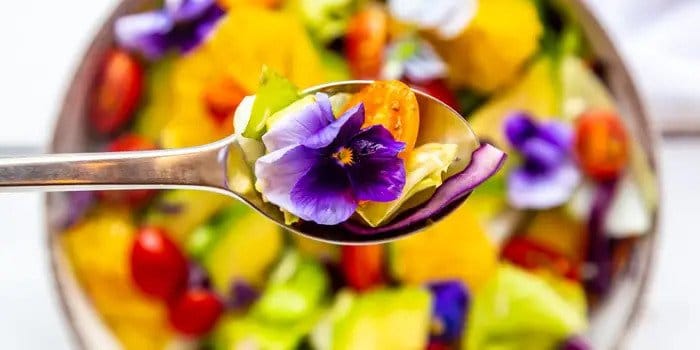
First Get Familiar
Not all flowers are edible. Some are extremely toxic. The flowers you use in your kitchen must be food quality. This means that they need to be grown in a manner in which they are not exposed to any toxins or chemicals, and have not been treated with pesticides or preservatives. It is best to buy edible flowers at the food market so you can be sure they’re suitable for eating. If you should decide to grow them yourself, you need to know what you are doing. Taking classes or reading a reliable book on edible flowers is a must.
Flowers to Avoid
Here is a partial list of common poisonous plants in your landscape that should not be eaten:
- Aconite
- Anemone
- Anthurian
- Autumn Crocus
- Azalea
- Boxwood
- Buttercup
- Butterfly Weed
- Caladium
- Calla Lily
- Carolina Jasmine
- Castor Bean
- Cherry Laurel
- Chinaberry
- Clematis
- Daffodil
- Deadly Nightshade
- Delphinum
- Dumbcane
- Elephant Ears
- False Hellebore
- Four O’Clock
- Foxglove
- Gardenia
- Gloriosa Daisy
- Heavenly Bamboo
- Horse Chestnut
- Hyancinth
- Hydrangea
- Iris
- Ivy
- Jessamine
- Jimson Weed
- Jonquil
- Lantana
- Lily of the Valley
- Lobelia
- March Marigold
- May Apple
- Mistletoe
- Morning Glory
- Nightshade
- Oleander
- Periwinkle
- Pointsettia
- Poison Hemlock
- Potato
- Privet
- Rhododendron
- Philodendron
- Schefflera
- Star of Bethlehem
- Sweet Pea
- Tobacco
- Tomato (blooms)
- Trumpet Vine
- Water Hemlock
- Wild Cherry
- Wisteria
- Yellow Oleander
Start Using Edible Flowers
A good way to start using edible flowers is in a salad. You can even make a salad dressing using flowers. Another way to use them is as a garnish. A flower floating in the soup is a sure way to get conversation going at the table. Be sure to remind everyone to eat the flower (the one in the soup, not the centerpiece). Speaking of floral centerpieces, the flowers in them are absolutely nonedible, unless they came from an “organic-food” florist or you made the centerpiece yourself using edible flowers.
Purchasing Your Petals
When buying edible flowers, look for flowers that have recently opened and do not have any holes or spots. Before using any edible flowers, wash them gently in cold water. After washing, refresh them by placing them in a bowl of ice water for about one minute. Drain on a clean white cloth or on white paper towels. You may also want to taste a petal or two to familiarize yourself with the flavor.
Edible flowers may not become a part of everyday dining, but they can be an impressive and fun way to brighten both the appearance and flavor of any dish — and they’re sure to put a smile on the faces of your guests at your next dinner party.
Edible Flowers Recipes
Following are some recipes using edible flowers to give you a few suggestions.
Candied Flowers
What you will need:
- One egg white (please use powdered egg whites to avoid salmonella)
- 100 proof vodka
- Superfine granulated sugar
- Thin artist’s paintbrush
- Violets, pansies, Johnny-jump-ups, rose petals, lilac, borage, pea, pinks, scented geraniums
- Wire rack
Directions:
Beat egg whites until frothy. Add a couple of drops of vodka to help the flowers dry quicker. Using fresh picked flowers, paint each flower individually with beaten egg white using the artist’s paintbrush. When thoroughly coated, sprinkle with fine sugar and place on the wire rack to dry. Flowers are completely dry when stiff and brittle to the touch. They can be stored in an airtight container and put in the freezer for up to a year. A simple bakery cake can be turned into a work of art by garnishing with candies flowers.
Idea: Try a chocolate cake decorated with fresh raspberries and candied rose petals.
Floral Liqueur
What you will need:
- 4 cups vodka or brandy
- 1-cup sugar
- 1 to 2 cups flowers
Directions:
Place lightly bruised petals in a jar with vodka or brandy and steep for two days. Then, add sugar and steep for two weeks, shaking vigorously once or twice a day to let sugar dissolve. Strain and filter into clean decanter.
Ideas:
- Rose, carnation, lavendar and mint
- Orange zest and mint
- Ginger and pear
- Peaches and lemon verbena
- Raspberry and lemon balm
- Use a dry white wine
Flower Butter
What you will need:
- 1/2 – 1 cup chopped fresh or dried petals
- 1 pound sweet unsalted butter
Directions:
Finely chop flower petals and mix into softened butter. Let mix stand for several hours at room temperature, then refrigerate for several days to bring out the flavour. Can be frozen for several months. Wonderful on breads or used in sugar cookie or pound cake recipes.
Ideas:
- Cream cheese
- Rose, lavendar or sunflower
- Add some herbs i.e., basil, thyme, garlic
Flower Honey
What you will need:
- 1/2 – 1 cup fresh or dried petals
- 1 pound honey
Directions:
Add chopped or crushed flowers to honey. Loosely cover jar and place in a pan half full of gently boiling water. Remove from heat, and let sit in the hot water for ten minutes. Remove jar from water and let cool to room temperature. Allow jar of honey with flowers to sit for one week. Flowers can then be strained out if desired.
Flower Jelly
What you will need:
- 2-1/2 cups apple juice OR white wine
- 1 cup fresh rose petals or scented geranium flowers and leaves
- 4 cups sugar
- 1/4 lemon juice
- 1 – 2 drops food colouring (optional)
- 3 ounces of liquid pectin
- Fresh flower petals (optional)
Directions:
Bring juice or wine to a boil and pour over petals. Cover and steep until liquid has cooled, then strain out flowers leaving only liquid. Combine 2-cups of this flower infusion with sugar, lemon juice and food colouring. Bring to a boil over high heat and as soon as the sugar has dissolved, stir in the pectin. Return to a rolling boil, stirring, and boiling for exactly one minute. Remove the jelly from the heat and skim off any foam. Let jelly cool slightly and add more flower petals (if desired), then pour into sterilized jars. If petals do not stay suspended, stir jelly as it cools until petals stay in place. Process in hot water bath or seal with paraffin.
Yields: 4 – 5 half pints
Flower Oil
What you will need:
- 1/2 – 1 cup fresh or dried flowers
- 1 quart vegetable oil
Directions:
Add flowers to bottle of oil and place in a pan of water. Simmer water with bottle in it gently for at least 30 minutes. Remove from stove and cool. Cover bottle tightly, and let steep a week before using. If dried flowers are used, they may be left in the oil. Fresh flowers should be drained after one week as they lose their color.
Nasturium and herb blossom oils are excellent for sauteing.
Rose and carnation oils make nice salad dressings.
Flower Syrup
What you will need:
- 1-cup water (or rosewater)
- 3 cups sugar
- 1/2 – 1-cup flower petals, whole or crushed
Rose and carnation oils make nice salad dressings.
Directions:
Boil all ingredients for ten minutes, or until thickened into syrup. Strain through a cheesecloth into a clean glass jar. Keeps up to two weeks in the refrigerator. Can be added to sparkling water or champagne for a delicious beverage. Or, it may be poured over fruit, pound cake or pancakes.
Zucchini Blossom Frittata
What you will need:
- 2 tablespoons canola oil
- Two to three cloves minced garlic
- 1/2 cup chopped onion
- 1/4 cup chopped red pepper
- About 12 Zucchini Blossoms, washed and dried
- 1 tablespoon chopped fresh basil
- 1/2 tablespoon chopped fresh oregano
- Four large eggs
- Salt and pepper
Directions
Heat the oven to 400-degrees.
In a large ovenproof skillet, heat the canola oil over medium heat. Add the garlic, onion, and red pepper. Saute about one minute. Add the Zucchini Blossoms and cook, stirring occasionally, for about ten minutes until they are lightly browned. Add the basil and oregano. Stir to mix well.
In a medium bowl, whisk the eggs with salt and pepper to taste, until well blended. Add to the skillet, and stir to blend well. Lower the heat and cook until the eggs are just set. Put the skillet into the oven and bake until done, about 15-20 minutes. Slice into wedges and serve. Can be served hot or at room temperature.
Recipe makes four servings.
Read More: Keto Charge Reviews: Best Keto Pill 2022

